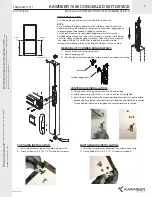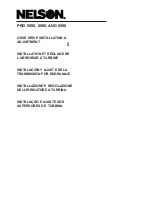
65
I-800
2
Style #899 FireLock CPVC One-Step Solvent Cement
SECTION V – Health Hazard Data
Primary Route(s) of Entry:
Inhalation?
Skin?
Eye?
Ingestion?
Yes
Yes
No
No
Effect of Overexposure
ACUTE: Inhalation: Severe overexposure may result in nausea, dizziness, headache. Can cause drowsiness,
irritation of eyes and nasal passages.
Skin Contact: Skin irritant. Liquid contact may remove natural skin oils resulting in skin irritation.
Dermatitis may occur with prolonged contact.
Skin Absorption: Prolonged or widespread overexposure may result in the absorption of harmful amounts
of material.
Eye Contact: Overexposure may result in severe eye injury with corneal or conjuctival inflammation on
contact with the liquid. Vapors slightly uncomfortable.
Ingestion: Moderately toxic. May cause nausea, vomiting, diarrhea. May cause mental sluggishness.
CHRONIC: Symptoms of respiratory tract irritation and damage to respiratory epithelium were reported
in rats exposed to 5000 ppm THF for 90 days. Elevation of SGPT suggests a disturbance in liver function.
The NOEL was reported to be 200 ppm.
Medical Conditions Generally Aggravated By Exposure
Individuals with pre-existing diseases of the eyes, skin or respiratory system may have increased
susceptibility to the toxicity of excessive exposures.
Emergency and First Aid Procedures
Inhalation: If overcome by vapors, remove to fresh air and if breathing stopped, give artificial
respiration. If breathing is difficult, give oxygen. Call physician.
Eye Contact: Flush eyes with plenty of water for 15 minutes and call a physician.
Skin Contact: Remove contaminated clothing and shoes. Wash skin with plenty of soap and water for at
least 15 minutes. If irritation develops, get medical attention.
Ingestion: Give 1 or 2 glasses of water or milk. Do not induce vomiting. Call physician or poison control
center immediately.
SECTION VI – Reactivity Data
Stability
Unstable
Conditions to Avoid
Keep away from heat, sparks, open flame and
other sources of ignition.
Stable
X
Incompatibility
(Materials to avoid)
Caustics, ammonia, inorganic acids, chlorinated compounds, strong oxidizers and isocyanates.
Hazardous Decomposition or By-products
When forced to burn, this product gives out carbon monoxide, carbon dioxide, hydrogen chloride and
smoke.
Hazardous Polymerization
May Occur
Conditions to Avoid
Keep away from heat, sparks, open flame and
other sources of ignition.
Will not Occur
X
SECTION VII – Spill or Leak Procedures
Steps to be Taken in Case Material is Released or Spilled
Eliminate all ignition sources. Avoid breathing of vapors. Keep liquid out of eyes. Flush with large
amount of water. Contain liquid with sand or earth. Absorb with sand or nonflammable absorbent material
and transfer into steel drums for recovery or disposal. Prevent liquid from entering drains.
Waste Disposal Method
Follow local, State and Federal regulations. Consult disposal expert. Can be disposed of by
incineration. Excessive quantities should not be permitted to enter drains. Empty containers should be
air dried before disposing. hazardous Waste Code: 214
SECTION VIII – Special Protection Information
Respiratory Protection (Specify Type)
Atmospheric levels should be maintained below established exposure limits contained in Section II. If
airborne concentrations exceed those limits, use of a NIOSH-approved organic vapor cartridge respirator
with full face-piece is recommended. The effectiveness of an air purifying respirator is limited. Use
it only for a single short-term exposure. For emergency and other conditions where short term exposure
guidelines may be exceeded, use an approved positive pressure self-contained breathing apparatus.
Ventilation
Use only with adequate ventilation. Provide sufficient ventilation in volume and pattern to keep
contaminants below applicable exposure limits set forth in Section II. Use only explosion proof
ventilation equipment.
Protective Gloves
PVA Coated
Eye Protection
Splashproof chemical goggles
Other Protective Equipment and Hygienic Practices
Impervious apron and a source of running water to flush or wash the eyes and skin in case of contact.
SECTION IX – Special Precautions
Precautions to be taken in Handling and Storing
Store in the shade between 40˚F - 100˚F. Keep away from heat, sparks, open flame and other sources of
ignition. Avoid prolonged breathing of vapor. Use with adequate ventilation. Avoid contact with eyes,
skin and clothing. Train employees on all special handling procedures before they work with this
product.
Other Precautions
Follow all precautionary information given on container label, product bulletins and our solvent
cementing literature. All handling equipment should be electrically grounded.
®
10.82
I-800 2755 Rev_I.fm Page 65 Tuesday, September 13, 2005 8:46 AM




































